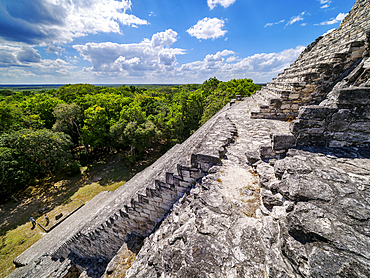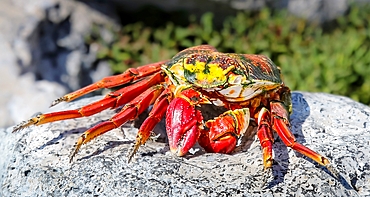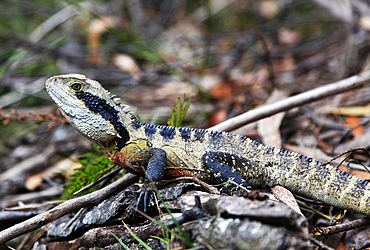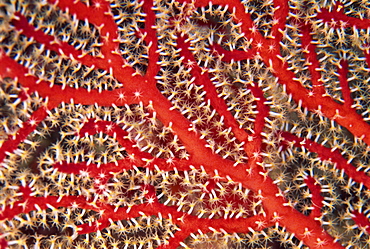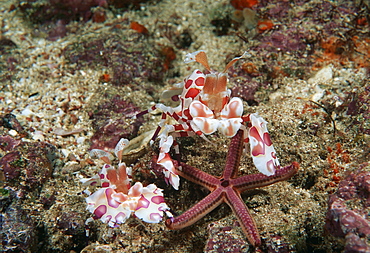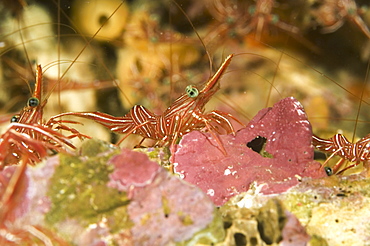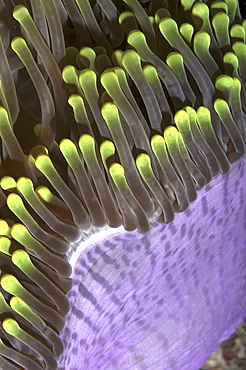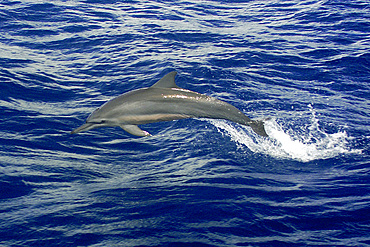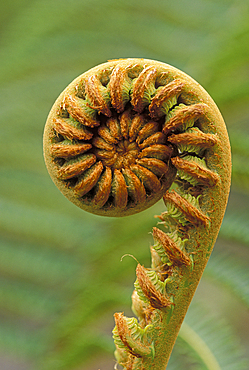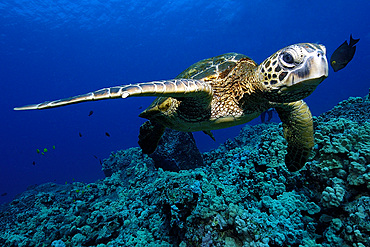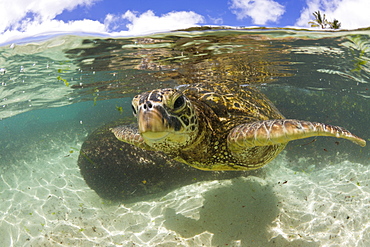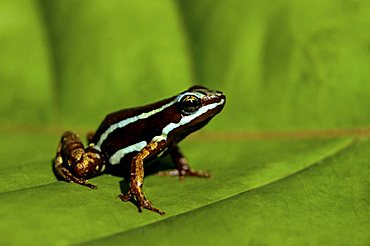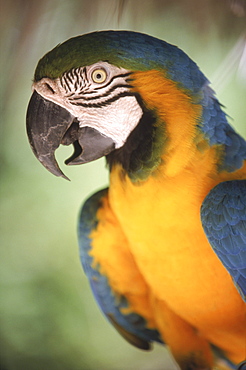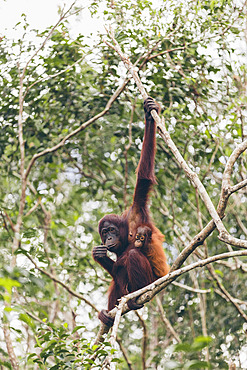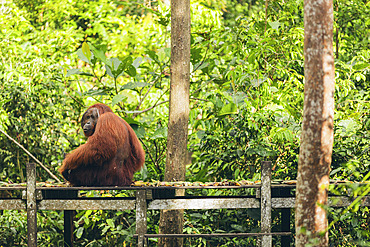Results
« Previous 1 2 3 4
316 results found
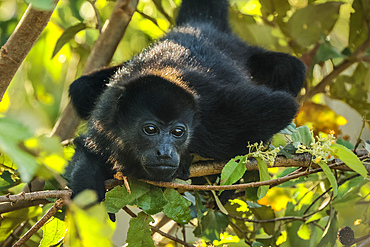
Juvenile mantled howler monkey (Alouatta palliata) in Pacific coast forest, known for their loud call, Esperanza, Nosara, Guanacaste, Costa Rica

Wood stork (Mycteria americana) big wading bird of the south Americas, scavenging on black sand turtle beach, Ostional, Guanacaste, Costa Rica
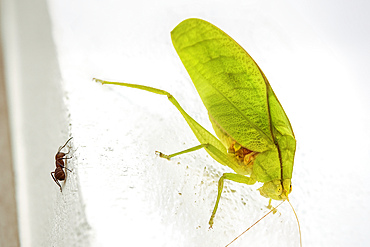
Round-headed katydid (bush cricket) (Amblycorypha), earhole in forelegs, superb leaf mimic with leg scraping song, Guanacaste, Costa Rica
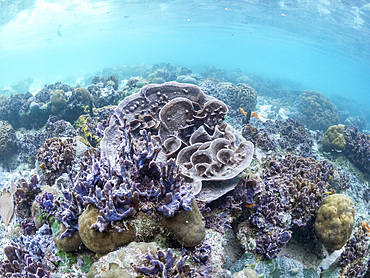
A myriad of hard and soft corals compete for space on the substrate of Darwin's Wall, Palau, Micronesia, Pacific
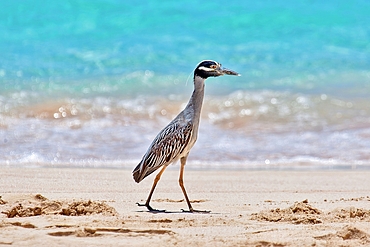
Yellow Crowned Night Heron (Nyctanassa Violacea), wading bird of the Americas that feeds on crustacea, Bermuda, Atlantic
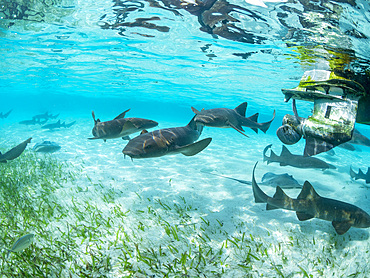
Nurse sharks (Ginglymostoma cirratum), being fed in shark and ray alley, Caye Caulker, Mesoamerican Barrier Reef, Belize

A sleek blue shark (Prionace glauca) cruises through the cold waters off Cape Cod, Massachusetts, in the Atlantic Ocean. These beautiful elasmobranchs are found throughout the world in both temperate and tropical seas and are a species listed as Near Thre
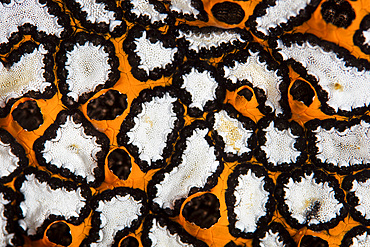
Detail of a colonial tunicate growing on a reef in Raja Ampat, Indonesia. This remote, tropical region is home to extraordinary marine biodiversity.
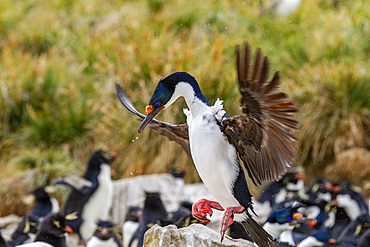
Imperial shag (Phalacrocorax atriceps), returning to the nest on New Island in the Falkland Islands, South America
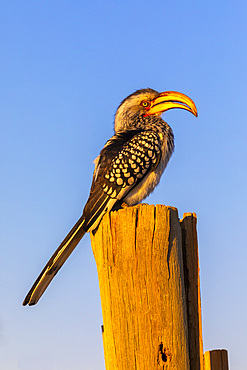
Southern yellow billed hornbill, Pilanesberg National Park, North West Province, South Africa, Africa

Frog in the forest, French Guiana, Overseas department and region of France, French Guiana, South America
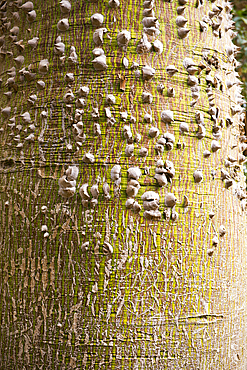
Floss silk tree (Ceiba speciosa), Botanical Garden on El Nabatat Island (Kitchener's Island), Aswan, Egypt, North Africa, Africa
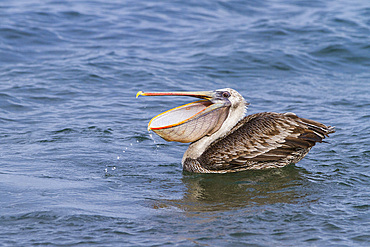
Galapagos brown pelican (Pelecanus occidentalis urinator) feeding in the Galapagos Island Archipelago, UNESCO World Heritage Site, Ecuador, South America
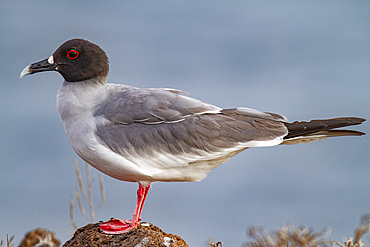
Adult Swallow-tailed gull (Creagrus furcatus) on Espanola Island in the Galapagos Island Archipelago, UNESCO World Heritage Site, Ecuador, South America
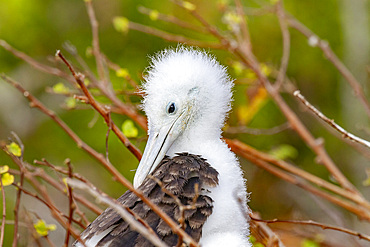
Great frigatebird (Fregata minor) chick in the nest in the Galapagos Island Archipelago, UNESCO World Heritage Site, Ecuador, South America
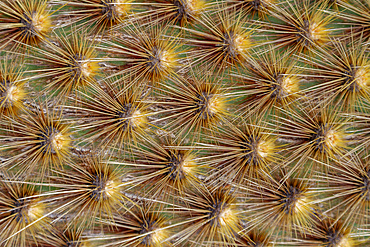
The endemic Opuntia cactus (Opuntia echios) cactus growing in the Galapagos Island Archipelago, UNESCO World Heritage Site, Ecuador, South America
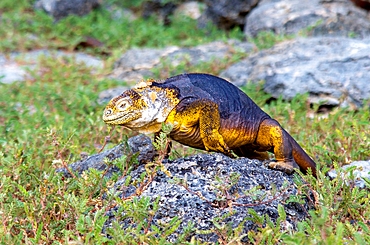
Galapagos Land Iguana (Conolophus subcristatus), can grow to five feet long and live for 60 years, South Plaza island, Galapagos, UNESCO World Heritage Site, Ecuador, South America
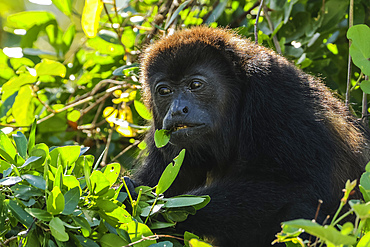
Female mantled howler monkey (Alouatta palliata) known for its loud call, eating in Pacific coast forest, Esperanza, Nosara, Guanacaste, Costa Rica
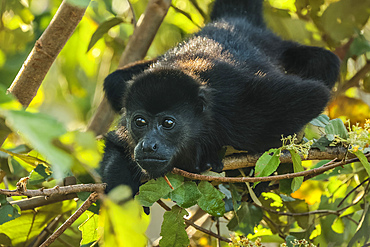
Juvenile mantled howler monkey (Alouatta palliata) in Pacific coast forest, known for their loud call, Esperanza, Nosara, Guanacaste, Costa Rica

Neotropic cormorant (Phalacrocorax brasilianus) (Phalacrocorax olivaceus) (Nannopterum brasilianum), Lake Sandoval, Tambopata National Reserve, Peru, South America

Adult Swallow-tailed gull (Creagrus furcatus) in the Galapagos Island Archipelago, UNESCO World Heritage Site, Ecuador, South America

Nazca booby (Sula grantii) downy chick in the Galapagos Island Archipelago, UNESCO World Heritage Site, Ecuador, South America
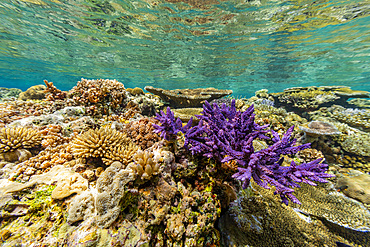
A myriad of hard and soft corals at Vatu-I-Ra Conservation Park on Viti Levu, Fiji, South Pacific, Pacific

Jungle myna (Acridotheres fuscus), looking for water at the Volivoli Resort grounds on Viti Levu, Fiji, South Pacific, Pacific
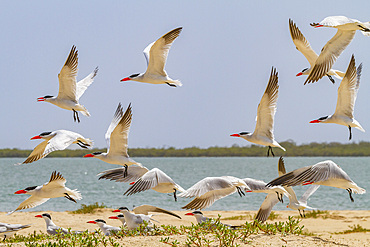
Caspian Terns (Hydroprogne caspia) at breeding colony on Ile des Oiseaux in the Parc National du Delta du Saloum, UNESCO World Heritage Site, Senegal, West Africa, Africa
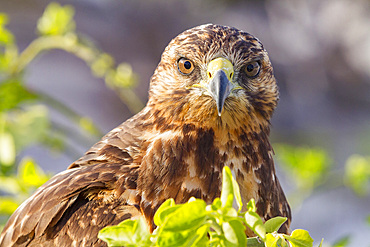
Young Galapagos hawk (Buteo galapagoensis) in the Galapagos Island Archipelago, UNESCO World Heritage Site, Ecuador, South America
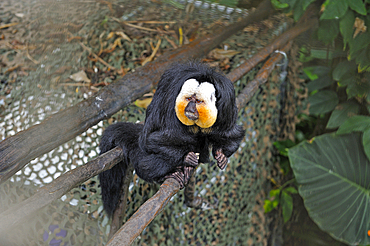
White-faced saki (Pithecia pithecia), Rainforest Pyramid, Moody Gardens, Galveston island, Gulf of Mexico, Texas, United States of America
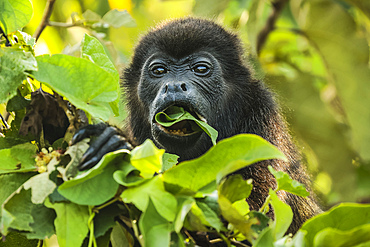
Female mantled howler monkey (Alouatta palliata) eating tree leaves in a north Pacific coast forest, Esperanza, Nosara, Guanacaste, Costa Rica
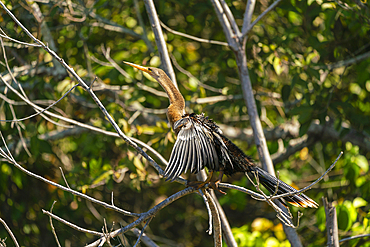
Anhinga (anhinga anhinga) perching on branch by Lake Sandoval, Tambopata National Reserve, Puerto Maldonado, Madre de Dios, Peru, South America

Adult sanderling (Calidris alba) feeding on the tidal flat in the Galapagos Island Archipelago, UNESCO World Heritage Site, Ecuador, South America
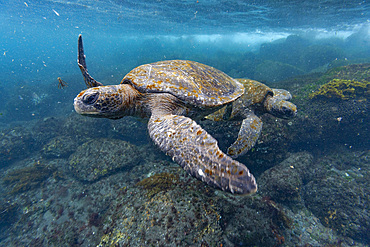
Adult green sea turtles (Chelonia mydas agassizii) underwater off the west side of Isabela, Galapagos Islands, UNESCO World Heritage Site, Ecuador, South America
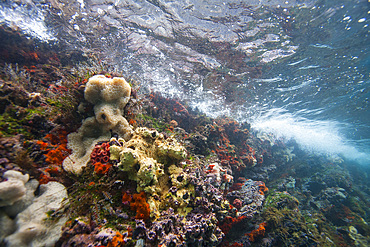
Underwater scenes from the Galapagos Island Archipelago, UNESCO World Heritage Site, Ecuador, South America
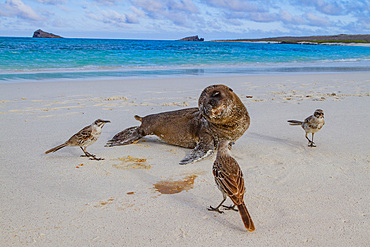
Galapagos sea lion (Zalophus wollebaeki) pup in the Galapagos Island Archipelago, UNESCO World Heritage Site, Ecuador, South America
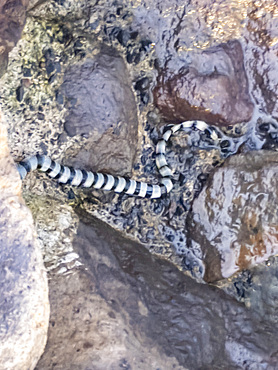
Adult yellow-lipped sea krait (Laticauda colubrina) snake, coming ashore at night on the Volivoli Resort grounds on Viti Levu, Fiji, South Pacific, Pacific

Young northern gannets (Morus bassanus) in flight near Ile des Oiseaux in the Parc National du Delta du Saloum, UNESCO World Heritage Site, Senegal, West Africa, Africa
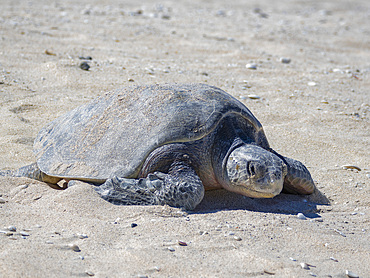
An adult female green sea turtle (Chelonia mydas), coming ashore to nest on Isla Espiritu Santo, Sea of Cortez, Mexico, North America
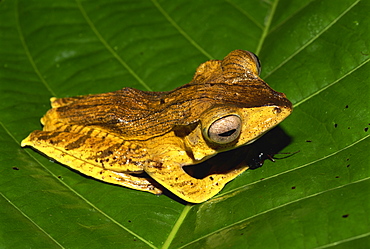
Unidentified Bornean tree frog species found in primary rainforest, Danum Valley, Sabah, Borneo, Malaysia, Southeast Asia, Asia
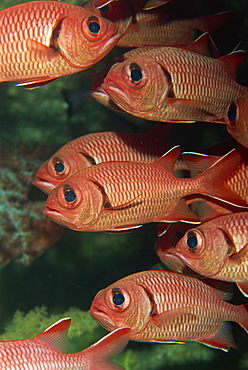
Schooling squirrel fish (Sargocentron species) are nocturnal, Similan Islands, Thailand, Southeast Asia, Asia
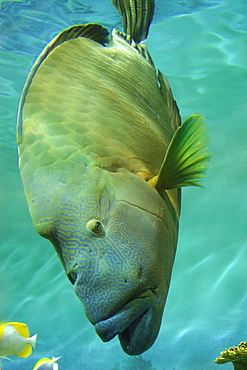
Humphead wrasse (Cheilinus undulatus), vulnerable species found in the Indo-Pacific Oceans, photo taken in captivity
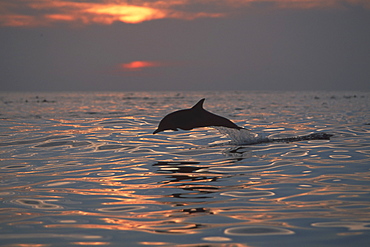
Long-beaked Common Dolphin (Delphinus capensis) at sunset in Northern Gulf of California, Mexico
(Restricted Resolution - pls contact us)
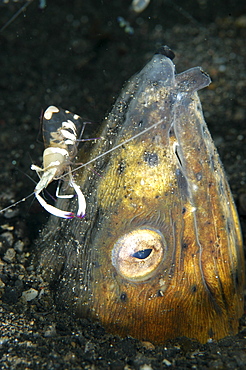
Black finned snake eel (Ophictus Melanochir) with short hand commensal shrimp (Palaemonidae).
Lembeh Straits, Indonesia.
(RR)
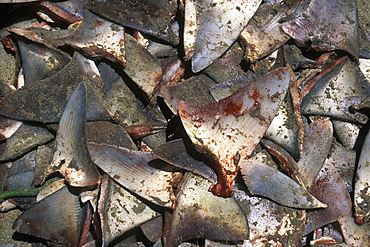
Shark dorsal fins cut from various species in the Shark Finning panga fishery in the Gulf of California (Sea of Cortez), Mexico.
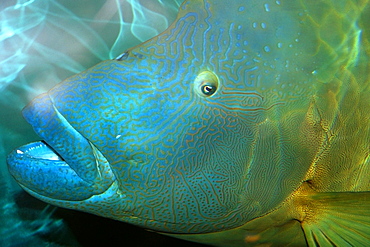
Humphead wrasse (Cheilinus undulatus) head detail, vulnerable species found in the Indo-Pacific Oceans, photo taken in captivity
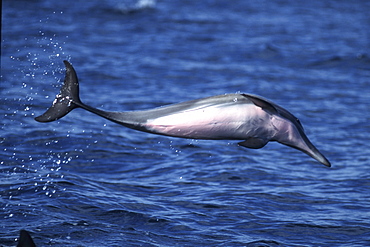
Long-beaked Common Dolphin, Delphinus capensis, pod leaping in Bahia de los Angeles, Baja California, Mexico
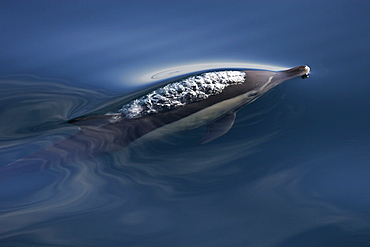
Long-beaked Common Dolphin (Delphinus capensis) surfacing in calm water off Isla Carmen in the Gulf of California (Sea of Cortez), Mexico.
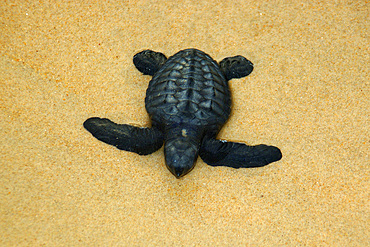
Olive ridley turtle hatchling, Lepidochelys olivacea, Costa do Sauipe, Bahia, Brazil (South Atlantic)
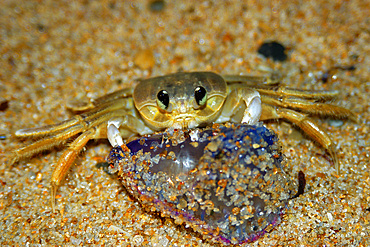
Crab preying on dead portuguese man-of-war, Physalia physalis, Praia do Forte, Bahia, Brazil (South Atlantic)
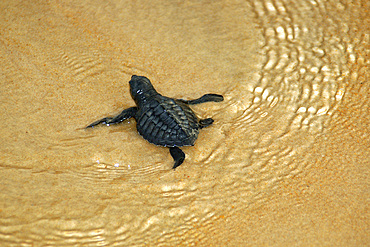
Olive ridley turtle hatchling, Lepidochelys olivacea, Costa do Sauipe, Bahia, Brazil (South Atlantic)
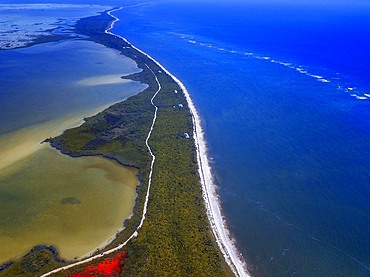
Aerial view of Punta Allen Sian Ka'an Reserve, Yucatan Peninsula, Mexico. Red lagoon near Boca Paila Bridge.
In the language of the Mayan peoples who once inhabited this region, Sian Ka'an means Origin of the Sky. Located on the east coast of the Yucatán peninsula, this biosphere reserve contains tropical forests, mangroves and marshes, as well as a large marine section intersected by a barrier reef. It provides a habitat for a remarkably rich flora and a fauna comprising more than 300 species of birds, as well as a large number of the region's characteristic terrestrial vertebrates, which cohabit in the diverse environment formed by its complex hydrological system.
Along its roughly 120 kilometres of coastline, the property covers over 400,000 hectares of land ranging from sea level to only ten m.a.s.l. The property boasts diverse tropical forests, palm savannah, one of the most pristine wetlands in the region, lagoons, extensive mangrove stands, as well as sandy beaches and dunes. The 120,000 hectares of marine area protect a valuable part of the Mesoamerican Barrier Reef and seagrass beds in the shallow bays. The lush green of the forests and the many shades of blue of the lagoons and the Caribbean Sea under a wide sky offer fascinating visual impressions.
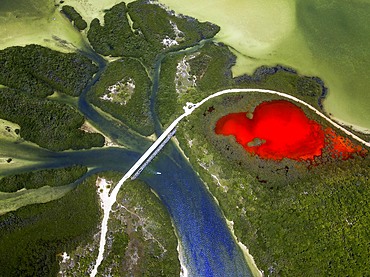
Aerial view of Punta Allen Sian Ka'an Reserve, Yucatan Peninsula, Mexico. Red lagoon near Boca Paila Bridge.
In the language of the Mayan peoples who once inhabited this region, Sian Ka'an means Origin of the Sky. Located on the east coast of the Yucatán peninsula, this biosphere reserve contains tropical forests, mangroves and marshes, as well as a large marine section intersected by a barrier reef. It provides a habitat for a remarkably rich flora and a fauna comprising more than 300 species of birds, as well as a large number of the region's characteristic terrestrial vertebrates, which cohabit in the diverse environment formed by its complex hydrological system.
Along its roughly 120 kilometres of coastline, the property covers over 400,000 hectares of land ranging from sea level to only ten m.a.s.l. The property boasts diverse tropical forests, palm savannah, one of the most pristine wetlands in the region, lagoons, extensive mangrove stands, as well as sandy beaches and dunes. The 120,000 hectares of marine area protect a valuable part of the Mesoamerican Barrier Reef and seagrass beds in the shallow bays. The lush green of the forests and the many shades of blue of the lagoons and the Caribbean Sea under a wide sky offer fascinating visual impressions.
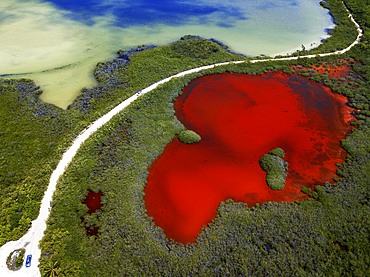
Aerial view of Punta Allen Sian Ka'an Reserve, Yucatan Peninsula, Mexico. Red lagoon near Boca Paila Bridge.
In the language of the Mayan peoples who once inhabited this region, Sian Ka'an means Origin of the Sky. Located on the east coast of the Yucatán peninsula, this biosphere reserve contains tropical forests, mangroves and marshes, as well as a large marine section intersected by a barrier reef. It provides a habitat for a remarkably rich flora and a fauna comprising more than 300 species of birds, as well as a large number of the region's characteristic terrestrial vertebrates, which cohabit in the diverse environment formed by its complex hydrological system.
Along its roughly 120 kilometres of coastline, the property covers over 400,000 hectares of land ranging from sea level to only ten m.a.s.l. The property boasts diverse tropical forests, palm savannah, one of the most pristine wetlands in the region, lagoons, extensive mangrove stands, as well as sandy beaches and dunes. The 120,000 hectares of marine area protect a valuable part of the Mesoamerican Barrier Reef and seagrass beds in the shallow bays. The lush green of the forests and the many shades of blue of the lagoons and the Caribbean Sea under a wide sky offer fascinating visual impressions.
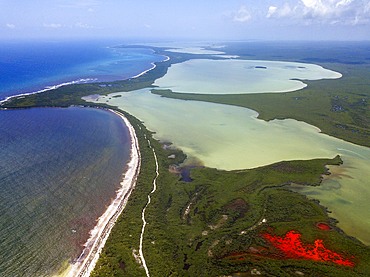
Aerial view of Punta Allen Sian Ka'an Reserve, Yucatan Peninsula, Mexico. Red lagoon near Boca Paila Bridge.
In the language of the Mayan peoples who once inhabited this region, Sian Ka'an means Origin of the Sky. Located on the east coast of the Yucatán peninsula, this biosphere reserve contains tropical forests, mangroves and marshes, as well as a large marine section intersected by a barrier reef. It provides a habitat for a remarkably rich flora and a fauna comprising more than 300 species of birds, as well as a large number of the region's characteristic terrestrial vertebrates, which cohabit in the diverse environment formed by its complex hydrological system.
Along its roughly 120 kilometres of coastline, the property covers over 400,000 hectares of land ranging from sea level to only ten m.a.s.l. The property boasts diverse tropical forests, palm savannah, one of the most pristine wetlands in the region, lagoons, extensive mangrove stands, as well as sandy beaches and dunes. The 120,000 hectares of marine area protect a valuable part of the Mesoamerican Barrier Reef and seagrass beds in the shallow bays. The lush green of the forests and the many shades of blue of the lagoons and the Caribbean Sea under a wide sky offer fascinating visual impressions.

Palms and old pier in Punta Allen Sian Ka'an Reserve, Yucatan Peninsula, Mexico.
In the language of the Mayan peoples who once inhabited this region, Sian Ka'an means Origin of the Sky. Located on the east coast of the Yucatán peninsula, this biosphere reserve contains tropical forests, mangroves and marshes, as well as a large marine section intersected by a barrier reef. It provides a habitat for a remarkably rich flora and a fauna comprising more than 300 species of birds, as well as a large number of the region's characteristic terrestrial vertebrates, which cohabit in the diverse environment formed by its complex hydrological system.
Along its roughly 120 kilometres of coastline, the property covers over 400,000 hectares of land ranging from sea level to only ten m.a.s.l. The property boasts diverse tropical forests, palm savannah, one of the most pristine wetlands in the region, lagoons, extensive mangrove stands, as well as sandy beaches and dunes. The 120,000 hectares of marine area protect a valuable part of the Mesoamerican Barrier Reef and seagrass beds in the shallow bays. The lush green of the forests and the many shades of blue of the lagoons and the Caribbean Sea under a wide sky offer fascinating visual impressions.
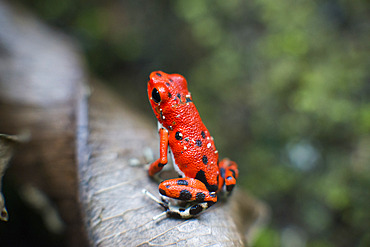
Strawberry Poison Frog (Dendrobates pumilio), adult, Bastimentos National Park, Bocas del Toro, Panama. The strawberry poison frog or strawberry poison-dart frog (Oophaga pumilio or Dendrobates pumilio) is a species of small amphibian poison dart frog found in Central America. It is common throughout its range, which extends from eastern central Nicaragua through Costa Rica and northwestern Panama. The species is often found in humid lowlands and premontane forest, but large populations are also found in disturbed areas such as plantations. The strawberry poison frog is perhaps most famous for its widespread variation in coloration, comprising approximately 15���30 color morphs, most of which are presumed to be true-breeding. O. pumilio, while not the most poisonous of the dendrobatids, is the most toxic member of its genus. The species is most diverse in Panama with varieties in vivid shades of all red, orange, blue, yellow or green, green and yellow, white with red, orange or black and spotted varieties. The most colorful mix is found in Isla Bastimentos Marine National Park though not all in one place. Colors vary by location. A beach on the north side of the island is named after the species. Two of Southern Explorations' Panama tours visit red frog habitat. Both the eight-day Panama Adventure trip and eleven-day Panama Highlights trip spend time in Isla Bastimentos Marine National Park and the former also goes to Red Frog Beach.
The red frog is not as poisonous as some of its cousins and is not a threat to humans. It subsists on a diet of ants that dine on poisonous plants, providing the red frog its protective skin toxin. Males attract females with a loud quick chirp. To hear the distinctive sound before you depart on your Panama tours, go to the University of Michigan Museum's biodiversity website (www.animaldiversity.ummz.umich.edu.) After birth, the tadpoles climb aboard the mother who deposits them in different protected areas where she retu
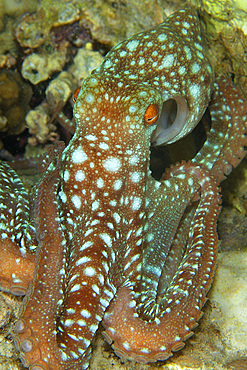
Starry night octopus, Octopus luteus, foraging on coral reef at night, Malapascua, Cebu, Philippines, Visayan Sea.

Green sea turtle, Chelonia mydas, gets cleaned by yellow tangs, Zebrasoma flavescens and lined bristletooth, Ctenochaetus striatus, Kailua-Kona, Hawaii, (N. Pacific)
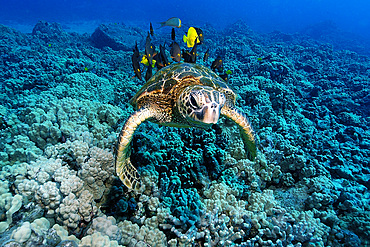
Green sea turtle, Chelonia mydas, gets cleaned by yellow tangs, Zebrasoma flavescens and lined bristletooth, Ctenochaetus striatus, Kailua-Kona, Hawaii, (N. Pacific)
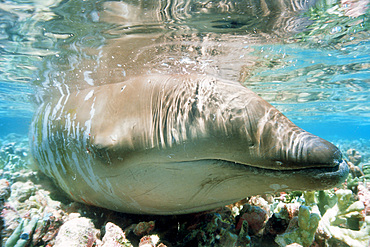
Beaked Whale stranded on coral reef during low tide, Mesoplodon sp., Mili, Marshall Islands (N. Pacific)..
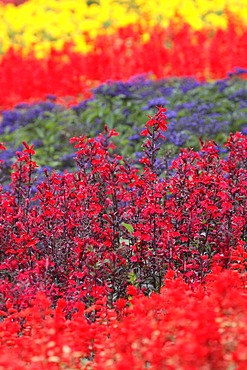
Colourful flowerbed planted with various summer flowers, Cardinal Flower (Lobelia fulgens), Scarlet Sage or Tropical Sage (Salvia splendens), Flossflower or Bluemink (Ageratum houstonianum)
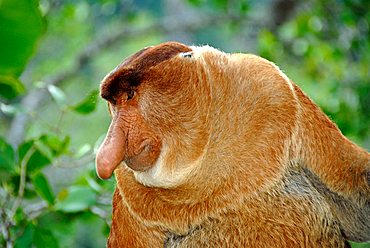
Portrait male Proboscis monkey in the tree in mangrove forest Bako National Park Sarawak Borneo Malaysia
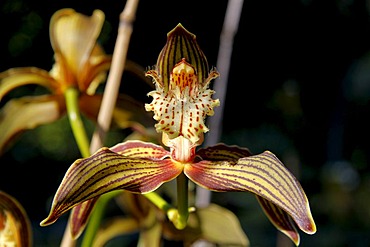
Orchid, orchid garden, Tropical Garden, Jardim Tropical Monte Palace, Jose Bernardo Foundation, Funchal, Madeira, Portugal, Europe
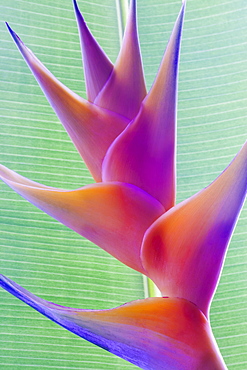
Close-up of a beautiful mixed pink Heliconia flower against a green leaf, Honolulu, Oahu, Hawaii, United States of America
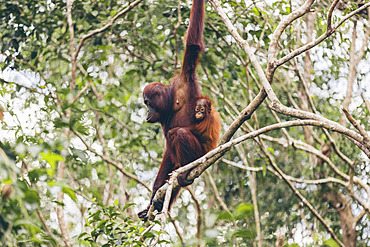
Orangutan (Pongo species) mother and baby together on a branch of a tree in Tanjung Puting National Park, Central Kalimantan, West Kotawaringin Regency, Indonesia
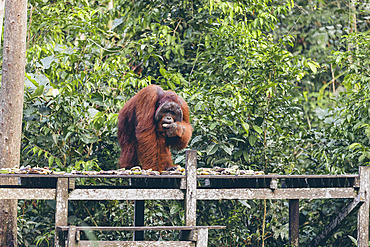
Orangutan (Pongo species) standing on a wooden platform eating fruit in Tanjung Puting National Park, Central Kalimantan, West Kotawaringin Regency, Indonesia
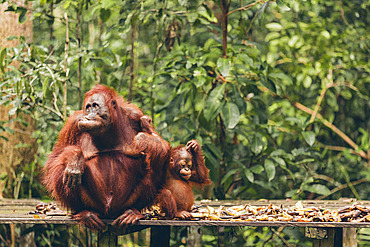
Orangutan (Pongo species) mother and baby sitting on a wooden platform in Tanjung Puting National Park, Central Kalimantan, West Kotawaringin Regency, Indonesia
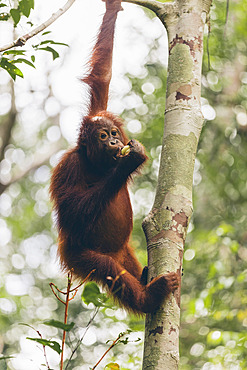
Orangutan (Pongo species) climbing a tree and eating a banana in Tanjung Puting National Park, Central Kalimantan, West Kotawaringin Regency, Indonesia
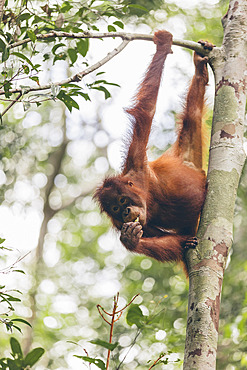
Orangutan (Pongo species) hanging sideways from a tree branch and eating a banana in Tanjung Puting National Park, Central Kalimantan, West Kotawaringin Regency, Indonesia
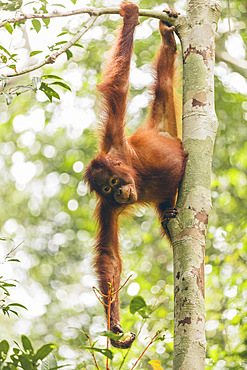
Orangutan (Pongo species) hanging sideways from a tree branch and holding a banana in it's hand in Tanjung Puting National Park, Central Kalimantan, West Kotawaringin Regency, Indonesia

Orangutan (Pongo species) sitting on a tree branch and eating in Tanjung Puting National Park, Central Kalimantan, West Kotawaringin Regency, Indonesia
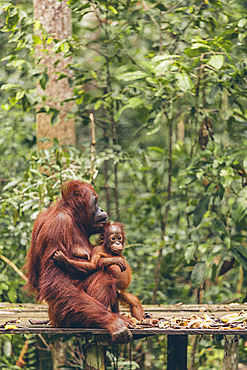
Orangutan (Pongo species) mother and baby together on a platform in Tanjung Puting National Park, Central Kalimantan, West Kotawaringin Regency, Indonesia
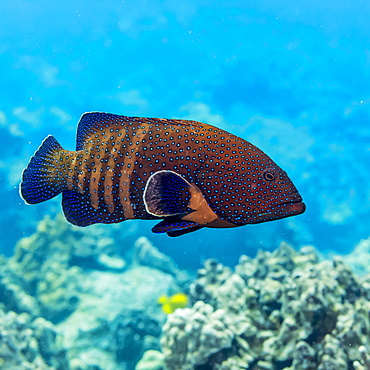
The Peacock Grouper (Cephalopholis argus) was deliberately introduced to Hawaii and is now considered an invasive species, Island of Hawaii, Hawaii, United States of America
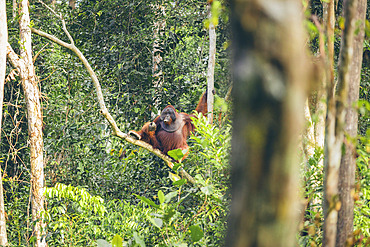
Orangutan (Pongo species) on a branch of a tree in Tanjung Puting National Park, Central Kalimantan, West Kotawaringin Regency, Indonesia
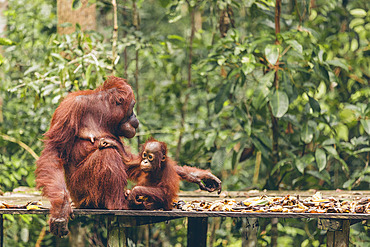
Orangutan (Pongo species) mother and baby together on a platform in Tanjung Puting National Park, Central Kalimantan, West Kotawaringin Regency, Indonesia
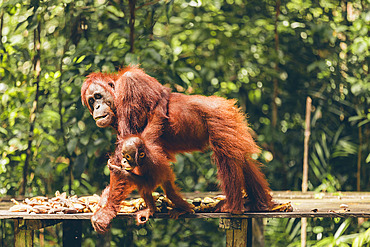
Orangutan (Pongo species) walking on a wooden board in Tanjung Puting National Park, Central Kalimantan, West Kotawaringin Regency, Indonesia
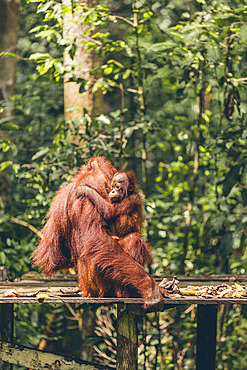
Orangutan (Pongo species) adult and young embracing while resting on a wooden board in Tanjung Puting National Park, Central Kalimantan, West Kotawaringin Regency, Indonesia
